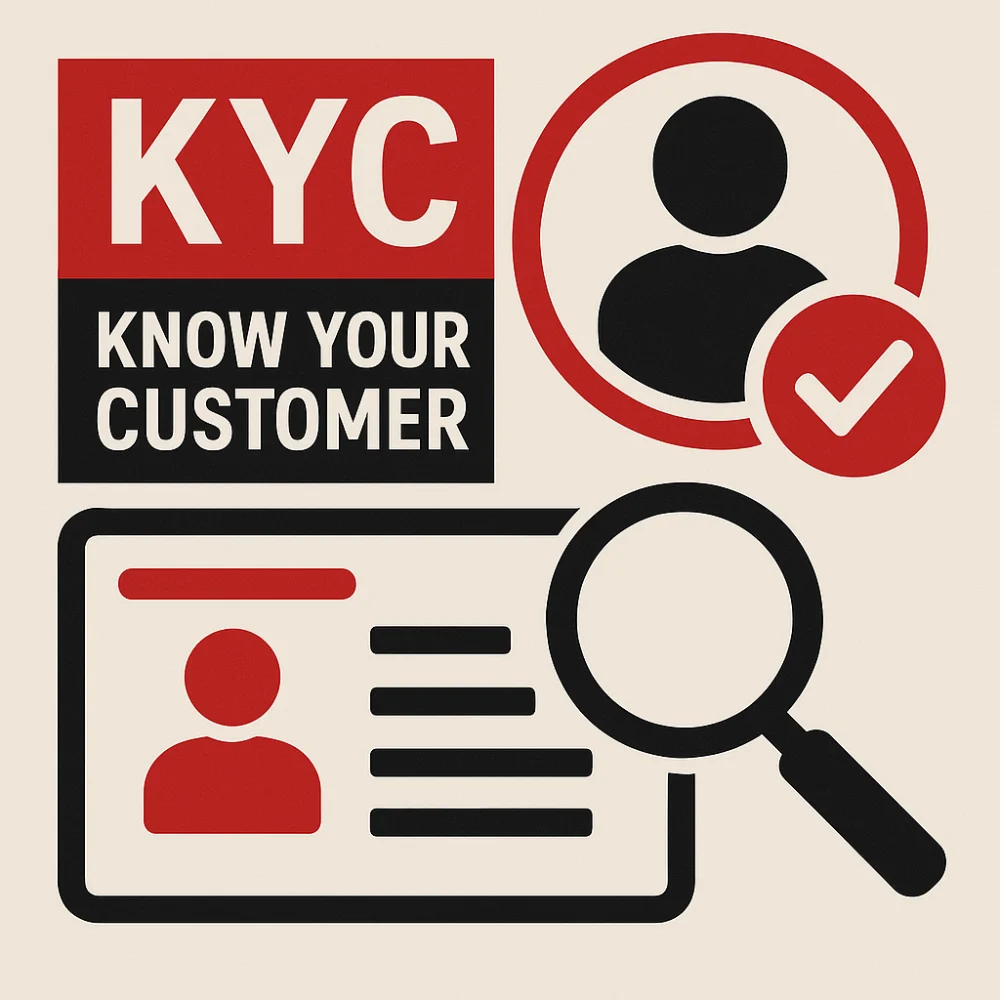Know Your Customer (KYC) verification is a critical component of any financial compliance program. KYC verification is the process of verifying an individual’s or entity’s identity to confirm that they are who they claim to be, minimizing the risk of fraud, money laundering, and terrorist financing.
The KYC process flow encompasses customer identification verification, risk-based assessments, ongoing KYC monitoring, and adherence to global regulations. Simple digital KYC verification takes a few minutes, whereas more complex investigations can take several business days or more.
In this article, we’ll discuss each phase of the KYC lifecycle in detail, from identity verification and KYC monitoring to investigations and reporting. We’ll look at KYC risks, compliance requirements, and sector-specific issues.
In addition, we’ll show you how open-source intelligence (OSINT) investigation techniques and OSINT tools like ShadowDragon can enhance KYC programs by uncovering hidden dangers, verifying identities, and streamlining compliance operations. With ShadowDragon Horizon™, analysts can start from a single data point like an email, alias, or domain and expand to identity attributes, related entities, and online footprints. These capabilities reduce the back-and-forth of jumping between registries, social profiles, and domain records manually during onboarding and investigations.
What is KYC Verification?

Know Your Customer (KYC) verification, also known as KYC identity verification, involves confirming a customer’s identity and understanding their financial situation to assess risk. The objectives of KYC are:
- Identification – Verifying that the person or company is who they say they are based on reliable and independent information or documents.
- Risk Assessment – Evaluate factors such as geography, occupation, transaction patterns, and ownership structures to assess the likelihood that the customer may be involved in money laundering, terrorist financing, or other financial crimes.
In short, KYC means knowing who you’re doing business with and the risk they present to your business. OSINT helps to confirm that story. Cross-check the stated entity details against public signals such as employer mentions, historical addresses, registered domains, and social media handles. ShadowDragon Horizon™ enables these checks and connects the dots between data points from a single platform.
This guiding principle underpins financial compliance frameworks worldwide and informs critical decisions about whether and how to onboard customers, continue monitoring their activity, and when to escalate for review.
How KYC Relates to CDD and AML
KYC, Customer Due Diligence (CDD), and Anti-Money Laundering (AML) are distinct, yet closely related, concepts. In general terms:
- KYC is the starting point. It’s about identity verification and creating a customer’s baseline risk before establishing a relationship.
- CDD builds upon KYC. It’s a risk-based approach applied during the ongoing relationship, involving regular due diligence for low-risk customers and enhanced due diligence (EDD) for high-risk customers, such as politically exposed persons (PEPs) and complex organizational structures.
- AML is the regulatory framework that includes KYC and CDD. It encompasses continuous transaction monitoring, suspicious activity reporting, and recordkeeping. AML aims to prevent and detect money laundering or terrorism financing.
In summary, KYC provides verified identity information, CDD involves risk assessment and ongoing due diligence, and AML is the regulatory framework governing these processes. A verified identity from KYC becomes the seed for OSINT enrichment in CDD. ShadowDragon Horizon™ adds context around external risks to inform ongoing AML monitoring and escalation.
Why KYC Matters

KYC is a business imperative. Not only is it legally and operationally required, but four primary factors make it simply non-negotiable for most firms:
Regulatory Compliance
Financial institutions must comply with KYC requirements as part of their legal obligations under international anti-money laundering frameworks and regulations.
The Bank Secrecy Act (BSA) in the U.S., the EU’s Anti-Money Laundering Directives (AMLD), the UK’s Money Laundering Regulations, and equivalent laws and regulations globally require firms to perform identity verification, maintain records, and report suspicious activity. Penalties for non-compliance can range into the hundreds of millions, and C-suite officers can be held personally accountable for non-compliance.
Auditors want to see clear, traceable justifications for every decision. ShadowDragon’s OSINT tools capture the original source data, timestamps, and every pivot path throughout the investigation. That means every conclusion reached is explainable, verifiable, and repeatable during audits, reviews, or regulatory investigations, supporting defensible intelligence workflows.
Risk Mitigation
KYC mitigates risk by helping to reduce money laundering, terrorist financing, fraud, identity theft, and other financial crimes. It enables institutions to understand who they’re working with and how they’re expected to transact, allowing issues to be detected earlier and before criminal funds are transferred or illicit accounts are opened.
OSINT reveals early warning signs that are often missed when relying solely on traditional watchlists, such as emerging online aliases or community reports linked to the customer. These signals help compliance teams identify hidden risks and act before formal alerts or sanctions appear.
Business Protection
Effective KYC procedures help protect the company against fines, legal sanctions, and reputational damage. Regulators and business partners require adequate KYC controls to be in place and enforced.
Without them, a firm’s banking relationships, market access, and shareholder value may be lost. Independent, open-source corroboration reduces false positives and supports brand reputation.
Building Trust
Customers and business partners are more likely to do business with a company that provides a secure KYC process that makes onboarding simple and transparent. By demonstrating a commitment to preventing financial crime, the firm can establish trust with its customers and foster long-term relationships.
The importance of all these factors makes KYC a non-negotiable requirement for any company that processes financial transactions or collects sensitive customer data.
Regulatory Frameworks Driving KYC Compliance
KYC frameworks may vary from region to region, but they are built upon a common foundation of global standards. The global standard is set by the Financial Action Task Force (FATF), which published the 40 Recommendations that determine the basic controls of an effective AML and Counter-Terrorist Financing (CTF) program.
National regulators interpret these standards differently and codify them into local laws, creating a shifting landscape of requirements that global financial institutions must continuously track and update as they expand operations.
FATF Recommendations
The FATF Recommendations serve as the basis for the risk-based compliance approach adopted by banks and fintechs worldwide. The FATF Recommendations require KYC controls for customer identification and beneficial ownership verification, as well as transaction monitoring and Enhanced Due Diligence (EDD) when higher risks are present. Most national KYC requirements align with FATF recommendations.
OSINT can help achieve FATF Rec. 10 and FATF Rec. 24 outcomes by corroborating customer identity and mapping beneficial ownership from public registries, corporate disclosures, and open web sources. ShadowDragon Horizon™ centralizes these investigative workflows for audit.
Regional and National KYC Frameworks
European Union (EU)
The EU’s Anti-Money Laundering Directives are continually updated, with the latest iteration (AMLD6) requiring central beneficial ownership registers, EDD for PEPs, and enhanced cross-border data sharing.
United Kingdom (UK)
The UK’s Financial Conduct Authority (FCA) and HM Treasury have maintained UK AML rules in alignment with the EU framework, employing the same risk-based approach and providing sector-specific guidance.
United States (US)
Customer Identification Programs (CIPs) and beneficial ownership reporting requirements are outlined in the BSA and FinCEN regulations. The focus is on customer due diligence and reporting suspicious activity, with recent changes including the establishment of a beneficial ownership registry and stricter filing deadlines.
India
The Reserve Bank of India (RBI) issues simplified KYC norms from time to time. With the latest norms, they have tried to strike a balance between financial inclusion and AML safeguards. This includes e-KYC for low-risk accounts.
Singapore
The Monetary Authority of Singapore’s (MAS) AML/CFT framework focuses on technology-enabled monitoring and provides clear guidelines for risk-based customer segmentation.
Risk-Based Application Across Jurisdictions
Despite differing language and reporting thresholds, the expectation is the same. The requirements are inherently risk-based and should be applied accordingly. OSINT tools like ShadowDragon Horizon™ help institutions operationalize this approach by revealing jurisdiction-specific risk signals, such as sanctions exposure or regional connections that are often missed when relying on static databases.
KYC programs from global organizations should be structured to meet FATF standards while remaining flexible and adaptable to local requirements, such as EDD for high-risk third countries in the EU, FinCEN’s beneficial ownership rules in the U.S., and digital onboarding requirements in MAS.
The KYC Verification Process: 8 Essential Steps

Step 1: Customer Identification Program (CIP)
A Customer Identification Program is the process of gathering and verifying a customer’s basic identity information before opening an account or commencing a transactional relationship. It forms the first step in KYC document verification and the broader KYC process.
Under CIP, institutions collect KYC identity verification details such as the customer’s full name, residential address, date of birth, and a government-issued identification number (e.g., passport, national ID, driver’s license). These documents are then authenticated, and the information is cross-checked against trusted sources, such as government databases or credit bureaus.
CIP requirements vary based on customer type:
- Individuals must provide personal identification documents and often proof of address.
- Corporate entities must provide business registration certificates, articles of incorporation, tax identification numbers, and details of beneficial owners and controllers. This helps the institution understand the natural persons who own or control the company.
Identity document verification technology, biometric verification, and trusted data sources are used to confirm the authenticity of identity information. These tools are useful for detecting tampered with or invalid ID images, expired licenses, or mismatched records, as well as automating verification checks against official registries or watchlists.
Pair document checks with open-source intelligence corroboration. With ShadowDragon Horizon™, investigators can confirm that names, emails, and addresses show a normal online footprint, spot reused usernames, and flag synthetic profiles with no history.
A robust CIP sets a verified foundation for ongoing due diligence and monitoring.
Step 2: Customer Due Diligence and Risk Profiling
Building on the verified identity established in Step 1, institutions proceed with Customer Due Diligence and risk profiling, a comprehensive, risk-based evaluation that both establishes an initial risk rating and supports ongoing, enterprise-level risk management.
Assess the Risk Profile
CDD begins with relationship-level checks to understand the customer’s potential exposure to money laundering, terrorist financing, or fraud. Analysts review:
- Customer type – individuals vs. corporate entities, and the complexity of their structures
- Geography – countries of residence, operation, or transaction corridors, including FATF high-risk or non-cooperative jurisdictions
- Business/occupation – industries with elevated cash flow or regulatory risk (e.g., casinos, cryptocurrency exchanges)
- Purpose and source of funds – origin of income, intended use of the account, and consistency of stated purpose with expected activity
OSINT enhances this stage by revealing contextual signals that formal documents often miss, such as undisclosed ownership links, extremist views, reputational red flags, or media and community activity consistent with declared business operations. ShadowDragon Horizon™ unifies these open-source findings alongside traditional CDD data, giving analysts a more complete picture of the customer’s risk posture before onboarding.
These factors yield an initial risk rating that informs onboarding decisions and determines the frequency of monitoring.
Tailor the Level of Due Diligence
Controls are scaled according to risk:
- Standard Due Diligence for typical customers, combining identity verification with baseline financial information.
- Simplified Due Diligence (SDD) for low-risk situations (e.g., government pension funds or low-value accounts).
- Enhanced Due Diligence for higher-risk customers, such as PEPs or entities in jurisdictions with weak AML controls, involving deeper investigation and tighter controls.
For SDD, use OSINT to keep friction low. For EDD candidates, OSINT can justify escalation with evidence from public records, historic posts, and digital connections. Horizon™ compiles that context into an auditable package without increasing the scope of data collection.
The initial ratings and risk factors established here flow directly into the enterprise-wide scoring and continuous risk updates described in Step 5.
Step 3: Beneficial Ownership and KYB (Know Your Business)
Just as with customers, regulatory compliance for business entities goes beyond just verifying the legal name provided on the application form. KYB involves understanding the natural person(s) who ultimately own or control the business, known as the ultimate beneficial owners (UBOs).
Identify and Verify UBOs
The institution must identify who directly or indirectly owns a significant stake (typically 25% or more) or who exercises effective control over the institution. Verification requires gathering personal ID documents for each UBO and validating with trusted sources.
OSINT tools like ShadowDragon Horizon™ extend this process by uncovering corroborating data from public records, social media presence, and corporate disclosures, helping investigators verify identities and flag inconsistencies early.
Map Control Structures and Detect Hidden Arrangements
Opaque corporate structures, featuring layered subsidiaries, nominee directors, or shareholders, can be used to conceal beneficial ownership. Mapping the control hierarchy helps detect circular ownership structures, shell companies, or straw owners used for illicit purposes.
ShadowDragon’s tools visualize relationships between entities, domains, and key individuals, helping to reveal hidden control or coordination patterns that traditional registry checks might miss.
Use Official Registries and Unique Identifiers
Regulators and industry groups are increasingly recommending the use of official business registries and global unique identifiers, such as the Legal Entity Identifier (LEI), to validate company data and monitor cross-border relationships. Aggregating this information can enhance due diligence and create an auditable chain of ownership evidence. With ShadowDragon Horizon™, investigators can incorporate OSINT-driven insights that provide defensible context for beneficial ownership mapping, ensuring that business relationships are both transparent and verifiable across jurisdictions.
If organizations have transparent visibility into who ultimately owns and controls the businesses they transact with, they can greatly reduce the risk that their services will be used for money laundering, tax evasion, or sanctions evasion.
Step 4: Sanctions and Watchlist Screening
Having confirmed the identity and ownership of a customer, the institution must also verify that the customer or any associated party is not barred from doing business with the institution. Sanctions and watchlist screening involves checking customers and their relevant connections against restricted-party lists before onboarding and throughout the customer relationship.
Sanctions and Watchlists
Customers, beneficial owners, and key counterparties are checked against major global and national sanctions lists, such as:
- U.S. Office of Foreign Assets Control (OFAC) Specially Designated Nationals (SDN)
- United Nations Security Council sanctions
- European Union restrictive measures
- Country-specific lists (e.g., UK, Canada, Singapore)
These lists identify individuals, companies, vessels, and jurisdictions subject to trade embargoes or financial restrictions. However, OSINT sources often reveal related entities, aliases, or infrastructure ties that sanctioned-party lists miss. Tools like ShadowDragon Horizon™ surface these links across domains, emails, and networks to expose indirect risk relationships.
Politically Exposed Persons and Adverse Media
Sanctions screening typically also covers PEPs, including public officials and their family members and close associates, who may pose a higher corruption risk. It also includes an adverse media review to surface negative news, such as allegations of fraud, bribery, or organized crime, that may not appear on official sanctions lists.
The ability of ShadowDragon’s OSINT platform to aggregate open source data, public social media activity, and publicly available information augments this process, helping investigators evaluate credibility and context before escalation.
Continuous Updates and Automated Tools
Sanctions lists and risk indicators can change daily. Financial institutions use automated, real-time systems to screen customers, beneficial owners, and even counterparty records against up-to-date watchlists and adverse media feeds.
These screening measures are a critical part of KYC checks. Robust systems incorporate fuzzy matching to minimize false positives and route matches that need manual evaluation to investigators. When escalations occur, ShadowDragon Horizon™ preserves source data, timestamps, and investigative pivots, creating an auditable record of why a match was confirmed or dismissed.
Note: This step represents the initial and event-triggered screening. Continuous re-screening (the ongoing, periodic checks that detect new designations or changes in customer circumstances) occurs later as part of the ongoing monitoring process (Step 7).
Thorough and timely sanctions and watchlist screening at onboarding, combined with later re-screening, protects institutions from regulatory penalties and reputational damage while ensuring compliance with global AML obligations.
Step 5: Enterprise-Level Risk Scoring
Institutions transition to this enterprise-level risk-scoring stage both after initial onboarding and continuously as customer activity occurs, moving beyond discrete due diligence decisions to capture and monitor data, which is then fed into dynamic, quantitative risk models for continuous, enterprise-wide risk management.
Data-Driven Modeling
Advanced analytics/machine-learning platforms ingest the CDD record, transaction history, sanctions-screening results, and adverse media hits. They output a composite risk score based on a variety of weighted factors, including transaction velocity, geographic exposure, counterparty behavior, and past trends of suspicious activity. Integrating OSINT insights into these models adds context beyond internal and regulatory data, capturing signals such as emerging reputational risks, or illicit infrastructure uncovered through ShadowDragon Horizon™.
Dynamic Rating Updates
Unlike the initial CDD rating, this risk scoring is dynamic and ongoing. The ratings are updated as additional information becomes available. For example, a customer’s risk rating may be increased due to a surge in cross-border wire activity, a name/structure change, or a regulatory alert issued for a customer’s country of operation.
Institution-Wide View
The aggregate results of this scoring are then fed into dashboards for senior compliance officers and regulators, as well as for capital allocation decisions, model validation exercises, enterprise risk appetite assessments, and other purposes. Automated triggers at this level can also trigger an automatic referral to EDD if the score breaches a threshold.
By transitioning from a static, customer-by-customer view to a continuous, data-driven enterprise-wide model, this step ensures risk management keeps pace with evolving behavior and regulatory expectations.
Step 6: Enhanced Due Diligence
In cases where a customer poses a higher risk based on geography, business sector, ownership, or politically exposed status, EDD may be conducted to provide greater assurance.
Gather Further Information
As part of an EDD process, institutions often require source-of-wealth and source-of-funds information to demonstrate how a customer accumulated assets and the origin of incoming funds. Audited financials, tax filings, and verified contracts for significant income streams may be used for this purpose.
OSINT sources can support these documents by surfacing additional details on asset ownership, undisclosed entities, and reputational risk exposure. ShadowDragon Horizon™ consolidates this intelligence in a central platform, giving investigators evidence-based confidence before escalation.
Conduct More Intensive Ongoing Monitoring
Ongoing monitoring of high-risk relationships typically requires more detailed scrutiny of transactions and shorter review cycles. Horizon™ Monitor offers real-time OSINT monitoring to detect emerging red flags, such as social connections to sanctioned actors or sudden shifts in online behavior, before they appear in transaction records.
In addition to transaction monitoring, many institutions conduct real-time screening against sanctions lists, perform daily re-screening of customer data, and conduct thorough reviews of counterparties to identify unusual activity as it occurs.
Require Senior Management Approval
Accounts subject to EDD are often required to be approved by senior management or the board. This is to ensure that senior management understands the risks associated with the relationship and that an enhanced level of oversight is in place to mitigate these risks.
Institutions use EDD measures where necessary to demonstrate to regulators that they are aware of and managing increased risk. By integrating ShadowDragon’s OSINT capabilities, compliance teams can document the rationale for escalation decisions using preserved source data and investigative trails, thereby strengthening auditability and regulatory compliance.
Step 7: Ongoing Monitoring
KYC is not a one-time process; it requires continuous monitoring to ensure that customer behavior remains aligned with the risk profile established during onboarding and that new threats are identified in a timely manner.
Track Transactions for Unusual Activity Patterns
Financial institutions actively monitor transaction volume, frequency, and counterparties for any suspicious activity that could indicate money laundering or terrorist financing.
Red flags include unusual spikes in wire transfers, unexplained cash deposits, or transactions involving high-risk countries or territories. Automated transaction monitoring systems alert investigators when activity deviates from established baselines.
OSINT intelligence feeds can also be used to flag external risk signals (company registrations, activity associated with the customer, online communities reporting suspicious activity, etc.) that may indicate developing exposure. ShadowDragon Horizon™ integrates these signals to strengthen early detection and alert context.
Perpetual or Trigger-Based KYC
Customer accounts are subject to periodic reviews based on risk ratings (e.g., annually for medium risk customers) as well as trigger-based reviews when changes occur to the customer or its transactions. These reviews function as ongoing KYC monitoring, including regular KYC checks to ensure accuracy over time.
Changes could include a change of beneficial owner or control structure, or significant changes to transaction patterns or volume. This process, also known as perpetual KYC, is used to maintain up-to-date customer records, adjust risk ratings as needed, and support targeted KYC investigations.
Suspicious Activity Reports
If an investigation determines that customer activity is suspicious, institutions must report this information to the relevant regulator. This might be the Financial Crimes Enforcement Network (FinCEN) in the US, the Financial Intelligence Unit (FIU) in the EU, or a similar national regulator.
These Suspicious Activity Reports (SARs) are filed within the prescribed time limit to avoid regulatory fines and support law enforcement. ShadowDragon Horizon™ preserves every data source, timestamp, and investigative path, giving analysts the defensible audit trail regulators expect.
Closing the KYC loop involves ongoing activities that keep customer information up to date, detect changes in risk profiles in real time, and file SARs as necessary to comply with AML regulations worldwide.
Step 8: Recordkeeping and Reporting
The final step in a complete KYC program is rigorous recordkeeping and reporting. This preserves an auditable trail of every decision, supporting both internal governance and regulatory oversight.
Retain KYC Documentation
Financial institutions are required to retain records of customer identification information, due diligence files, risk assessment results, and transaction histories for a period specified by applicable laws and regulations, typically ranging from five to seven years after the account is closed or the transaction is completed.
This information should be stored securely, in accordance with data protection standards, and in a manner that allows for easy retrieval when necessary. It can be stored on-site or, if managed with adequate controls, in a compliant cloud-based system.
Prepare for Audits and Ensure Traceability
Audits may take place at any time, and regulators will want to know not only what decisions were made but also why and how. This is why KYC recordkeeping and reporting are so important.
Auditors must be able to follow the verification, ownership, monitoring, and escalation steps without any gaps in traceability. Each decision and action taken should be adequately recorded, accompanied by explanations and, where appropriate, supporting evidence. ShadowDragon provides traceability by capturing each investigative step, allowing reviewers to reconstruct decision logic with full transparency.
Integrate with AML Monitoring and Reporting
KYC information also needs to integrate with and support the ongoing transaction monitoring system used for AML reporting. This will ensure timely and accurate detection of suspicious activity and the creation and submission of SARs or similar regulatory filings. KYC information can also support periodic regulatory reporting, such as beneficial ownership reporting.
Effective recordkeeping and reporting not only help to ensure compliance with reporting obligations but also enable quicker response to investigations. Integrating OSINT data from
ShadowDragon Horizon™ ensures that all intelligence used in decision-making is properly documented, defensible, and available for regulator review, closing the KYC loop with transparency and accountability.
How Long Does the KYC Verification Process Take?
The time required to complete KYC verification varies depending on the customer type, verification method, and risk profile. Simple, digital KYC verification using automated solutions can be completed in minutes, but only if it’s a straightforward case (i.e., clean identity documents and a low-risk profile).
Complex KYC cases can take several hours to a few business days or more, including corporate onboarding, KYC document verification across multiple jurisdictions, and enhanced due diligence verification for accounts. Cases are often delayed by missing, incomplete, low-quality, or suspicious documents, which require manual KYC checks and investigations.
In practice, most institutions seek a tradeoff: quick onboarding (low friction) while still completing identity checks and KYC document verification that meets regulatory standards.
OSINT tools like ShadowDragon Horizon™ help accelerate complex cases by surfacing identity data and reputational indicators from open sources, which reduces manual research time while maintaining evidentiary standards.
Industry Specific Considerations

KYC requirements and challenges can vary significantly across different industries. When designing your program and risk controls, consider the distinct transaction flows, customer interactions, and compliance obligations associated with your business sector.
Banking and Fintech
Banks and financial technology companies walk a fine line between fast customer onboarding and effective fraud mitigation. Quick customer acquisition shouldn’t come at the expense of the time and attention required for thorough identity verification and due diligence.
KYC processes in banking and fintech are often subject to regulatory audits, so it’s important that each step of your KYC process flow, from identity checks to risk scores and customer monitoring triggers, is fully documented. ShadowDragon Horizon™ strengthens this documentation by preserving all OSINT-derived findings, such as online identity traces, creating a transparent, auditable record of each verification step.
Good recordkeeping is also critical, as most banking regulators require that all KYC information and transactions be stored and easily accessible for at least five years.
Crypto Exchanges and VASPs
Virtual Asset Service Providers (VASPs) and cryptocurrency exchanges are experiencing increased scrutiny regarding source-of-funds verification. In addition to source-of-funds checks, these businesses must implement the FATF Travel Rule, which calls for sharing sender and recipient data for applicable transactions.
There are also higher fraud typologies in this industry that often involve mixing services, privacy coins, and cross-chain laundering; therefore, exchanges require real-time blockchain monitoring to prevent and detect these activities. OSINT complements blockchain analytics by uncovering off-chain exposure, such as connected domains, aliases, and social identities linked to wallets or mixing services. ShadowDragon’s tools bridge these intelligence gaps, helping exchanges identify bad actors before funds move.
Gaming and Marketplaces
Online gaming companies, betting operators, and peer-to-peer marketplaces often place withdrawal holds until customers complete KYC verification to prevent fraud and underage betting. Customer age and location verification should also be applied to KYC processes to comply with gambling regulations, consumer protection guidelines, and regional restrictions and limitations.
In addition to monitoring for new transactions, ongoing surveillance can be applied to gaming and marketplaces to identify the use of stolen payment cards and accounts, as well as to detect suspicious gaming or marketplace activities, such as unusual betting patterns or multiple accounts. OSINT investigations conducted via the ShadowDragon platform can reveal related accounts, shared infrastructure, and reused credentials across platforms, which helps compliance teams uncover coordinated fraud or account abuse faster.
Effective KYC programs adapt to these industry-specific realities while maintaining a risk-based framework that meets both global and local regulatory standards. Across sectors, OSINT-driven insights from ShadowDragon Horizon™ provide the adaptable, evidence-based visibility organizations need to meet those standards without slowing operations.
Implementation Checklist
A successful KYC program requires clear policies, the right technology stack, and controls for continuous oversight. Use the following checklist to guide execution:
Define Risk Policy and Workflows
- Define risk appetite and risk-based customer segmentation (low/medium/high).
- Document the KYC onboarding process and escalation workflow, including trigger events for manual reviews and enhanced due diligence.
Map Data Inputs
- Include all sources of data relevant to onboarding and monitoring customers: government registries, credit bureaus, sanctions lists, adverse media databases, and internal transaction logs.
- Consider all countries and regions in which your organization does business.
- Augment traditional data inputs with OSINT sources to capture intelligence beyond structured registries, such as public records, corporate disclosures, and domain or social data.
Choose Vendors and Set Pass/Fail Thresholds
- Choose identity verification, watchlist, and transaction-monitoring vendors that have a presence and regional coverage to meet your compliance needs.
- Include an OSINT platform like ShadowDragon in your vendor stack to enable deeper and wider reviews.
- Calibrate pass/fail or review thresholds to minimize false positives without compromising control effectiveness.
Build Fallback Mechanisms
- Define a manual review queue and process for handling cases where an automated system cannot make a confident decision.
- Include secure video verification or in-branch checks to resolve exceptions.
Instrument Metrics and Log Evidence
- Monitor a set of key process metrics, including onboarding cycle time, rate of false positives, and transaction alert resolution times.
- Store immutable logs of all steps in the verification process and final decisions for use in regulatory investigations and internal audits.
Is KYC Safe? Common Challenges in the KYC Process

When properly executed, KYC identity verification and KYC monitoring are intended to benefit both the institution and the customer. From secure data collection to encrypted storage and restricted access, KYC procedures are designed to safeguard sensitive identity information.
Reputable institutions choose certified vendors, adhere to data protection laws like GDPR and CCPA, and have their systems regularly audited for security compliance.
Most risks are not inherent to KYC but stem from its poor execution, such as inadequate vendor vetting, insufficient encryption, or inadequate monitoring. The absence of these controls can expose personal data, making it susceptible to breaches or misuse. OSINT tools like ShadowDragon Horizon™ can support vendor and partner due diligence by uncovering reputational red flags, compromised accounts, or prior breach exposure, helping compliance teams verify third-party integrity before sharing data.
In reality, KYC is far safer than not having it. KYC procedures protect institutions and customers by only allowing verified, legitimate individuals to access their services. This limits fraud, secures accounts, and ensures global regulatory compliance. For customers, it provides reassurance that their money and personal information are in a safer, more secure environment.
That said, there are some common pitfalls organizations may encounter when conducting KYC processes.
Common Challenges (and How to Avoid Them)
KYC programs at all levels of maturity consistently encounter these challenges. Planning to avoid these common pitfalls prevents compliance gaps, customer frustration, and wasted resources.
- Over-collecting data. Requesting unnecessary documentation prolongs onboarding and increases abandonment. Maintain a risk-based posture, requesting only the regulatory minimum and escalating only when risk warrants.
- Ignoring liveness. Static document checks are insufficient: without a liveness check (such as biometric selfies or video verification), an attacker can use a simple photo of someone else’s ID. Worse still, recent deepfake techniques can be used to generate false documents that bypass KYC systems. Leverage modern tools to detect signs of spoofing and confirm the physical presence of the individual.
- Brittle manual reviews. Manual review processes create backlogs, bottlenecks, and inconsistent decision-making. Structure manual review workflows by role and escalation path, and ensure quality control is in place. Integrate OSINT tools like ShadowDragon Horizon™ to reduce dependency on inconsistent manual searches. ShadowDragon unifies investigative data, from public records and identity traces, enabling reviewers to make defensible, evidence-backed decisions faster.
- Lack of ongoing monitoring. A one-time check at onboarding isn’t sufficient: if customer risk increases over time (such as a change in shareholders, negative sanctions listing, or transactional behavior), it’s too late for remediation. Set up continuous or trigger-based KYC monitoring to detect such changes over time. Horizon™ Monitor’s continuous OSINT monitoring helps identify emerging risks between review cycles, such as sudden ownership changes, shifts in digital footprint, or adverse media mentions that signal elevated exposure.
- Not planning for edge cases. Transliterations of names, low-quality ID documents, and “thin file” customers (without a financial history) can all trip up automated workflows. Plan for edge cases in your solution by allowing for fallback procedures when the primary system can’t reach a decision, for example, using secondary data sources or manual assisted onboarding.
- Friction in customer onboarding. Lengthy, complex onboarding processes result in high drop-off rates, particularly in fintech and marketplaces. Maintain low friction by automating verification, offering mobile-first workflows, and implementing tiered checks for low-risk accounts.
- High costs and resource intensity. KYC and AML teams can easily get bogged down in resource- and labor-intensive processes if oversight and exception handling are too manual. Strive to strike the right balance between automation and human review, and minimize vendor overlap whenever possible.
- Evolving regulations. Laws and regulations change frequently, with updates to FATF guidance, new AMLD legislation, new U.S. FinCEN guidance, and local registry requirements. Retain a regulatory watch function within your compliance team and ensure policies are updated as needed.
- Data quality and fraudulent documents. Low-quality scans of documents, expired IDs, or altered documents undermine data verification. This makes accurate KYC passport identification critical, particularly for global onboarding. Document forensics and trusted lookups of local registries can be used to detect tampering and ensure data accuracy. OSINT can supplement these checks by cross-referencing identity information against open corporate data, infrastructure links, and historical activity. ShadowDragon consolidates these data points, helping analysts confirm authenticity when documents appear questionable.
- False positives. Rule-based screening engines can generate unnecessary alerts and an unmanageable number of false positives. Tune screening engines for fuzzy matching and risk-based thresholds, and use feedback loops to refine models over time.
By planning for these common errors upfront, institutions can develop KYC programs that remain compliant over time and serve their customers effectively, without imposing unnecessary burdens on operations.
Best Practices for a Streamlined and Effective KYC Verification Process

Establishing and maintaining an efficient KYC lifecycle is key to a strong KYC program. Adhering to the following best practices can help institutions strike a balance between controls, efficiency, and customer experience.
Leverage Technology
Automated identity verification solutions, biometric matching, and machine learning–powered screening tools can dramatically reduce the time and manual effort required to onboard customers. This also helps improve accuracy, reduce false positives, and facilitate real-time monitoring at scale.
Integrating OSINT platforms like ShadowDragon Horizon™ extends these capabilities beyond structured data sources, continuously surfacing corroborating evidence, ownership links, and reputational signals from publicly available data to support automated KYC decisions and strengthen investigations.
Adopt a Risk-Based Approach
Institutions should implement controls and procedures in proportion to the risks they face. Applying simplified due diligence measures to low-risk customers and relationships can streamline the onboarding process, while high-risk cases should be subject to enhanced scrutiny. A risk-based approach allows for more efficient resource allocation while mitigating risk exposure.
Ensure Continuous Training
Regulatory requirements, typologies, and processes are always changing. Regularly provide training and education to front-line staff, KYC compliance officers, and KYC review teams. Training will enhance consistency and accuracy in identifying red flags.
Prioritize Data Security and Privacy
KYC and AML efforts rely on collecting and maintaining vast amounts of sensitive personal and financial data. This requires robust security controls, such as end-to-end encryption, access controls, and data minimization practices.
ShadowDragon’s OSINT tools follow these same principles: all data is live, it is not scraped, and it is only shown within a private dashboard or via an API connection. Each result is attributed to its original source, ensuring transparency and traceability without persistent data storage.
Meeting data privacy standards, such as GDPR, CCPA, and local regulations, is a legal requirement, but it’s also critical to maintaining customer trust.
Foster a Culture of Compliance
KYC/AML is most effective when compliance is viewed as an institutional priority rather than a burdensome afterthought. This begins with leadership setting the tone: senior management should promote a culture of compliance and accountability, ensuring the KYC program is adequately resourced and compliance with regulatory obligations is treated as a core business value.
Strengthening the KYC Lifecycle with ShadowDragon
KYC verification is a critical step in building safe and transparent customer relationships. KYC document verification, digital KYC verification, and other KYC process flow activities play a crucial role in meeting regulatory requirements, preventing financial crime, and establishing trust for businesses across industries such as banking, fintech, cryptocurrency exchanges, gaming, and others.
While KYC verification times can range from minutes for low-risk digital KYC onboarding to a few business days or more for riskier cases, the objectives remain the same: verifying identities, managing risk, and protecting your institution and customers through KYC checks and ongoing monitoring.
Effective KYC programs encrypt data, adhere to international privacy regulations, and protect customer data. The risks arise when programs are poorly implemented, lack strong verification, have inadequate monitoring, or lack the agility to keep pace with changing laws and regulations.
For this reason, an effective KYC program encompasses the entire KYC lifecycle, spanning onboarding and periodic reviews, continuous monitoring, and robust KYC investigations based on identified red flags.
This is where ShadowDragon can help. ShadowDragon offers advanced open-source intelligence (OSINT) tools that can extend and augment your current KYC workflows. By surfacing difficult-to-obtain identity attributes, mapping beneficial ownership, and revealing hidden risks in online activity or networks, ShadowDragon Horizon™ empowers compliance teams with the intelligence they need to quickly confirm identities, reduce false positives, and identify emerging threats.
Seamlessly integrated into your digital KYC verification platform, ShadowDragon enhances onboarding decisions and provides continuous visibility for ongoing monitoring. In a world where compliance, customer trust, and security go hand in hand, ShadowDragon helps organizations implement a resilient, intelligence-driven KYC approach.
With the right mix of automation, OSINT-driven insights, and perpetual vigilance, financial institutions can streamline compliance efforts, mitigate risk exposure, and safeguard their business from fraud, sanctions violations, and reputational damage, all while strengthening the entire KYC lifecycle. Contact us for a demo to discover how ShadowDragon can streamline your KYC verification process.





